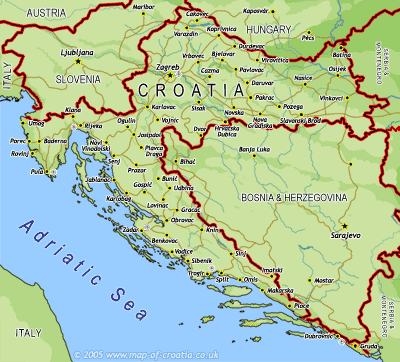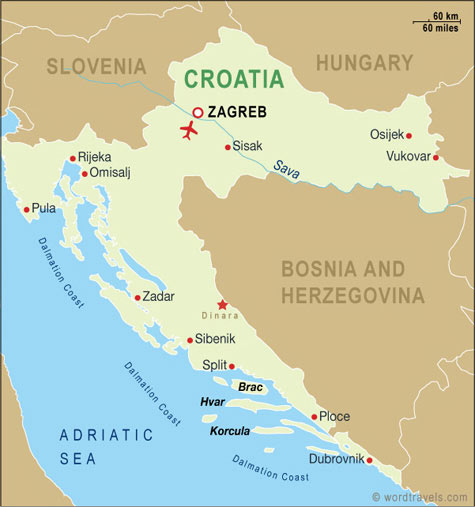The Croats arrived in the early 7th century in what today is Croatia. They organized the state into two dukedoms. The first king, King Tomislav was crowned in AD 925 and Croatia was elevated into the status of a kingdom. The Kingdom of Croatia retained its sovereignty for almost two centuries, reaching its peak during the rule of Kings Peter Krešimir IV and Demetrius Zvonimir. Croatia entered a union with Hungary in 1102. In 1527, the Croatian Parliament elected Ferdinand from the House of Habsburg to the Croatian throne. In 1918, Croatia was included in the short-lived State of Slovenes, Croats, and Serbs that declared independence from Austria–Hungary and co-founded the Kingdom of Yugoslavia. An independent Croatian state briefly existed during World War II. After World War II, Croatia became a founding member of the Second Yugoslavia.
On 25 June 1991, Croatia declared independence and became a sovereign state.
Croatia is a member of the United Nations, the Council of Europe, NATO, the World Trade Organization and CEFTA. The country is a candidate for European Union membership and is a founding member of the Union for the Mediterranean. Croatia is classified as an emerging and developing economy by the International Monetary Fund and a high income economy by the World Bank.* 1 History
o 1.1 Croatia before Croats
o 1.2 Kingdom of Croatia
o 1.3 Personal Union With Hungary
o 1.4 Republic of Poljica
o 1.5 Republic of Ragusa
o 1.6 Ottoman Wars
o 1.7 Austria–Hungary
o 1.8 National Revival
o 1.9 Kingdom of Yugoslavia
o 1.10 World War II
o 1.11 Socialist Yugoslavia
o 1.12 Independent Croatia
* 2 Geography
o 2.1 Administrative divisions
* 3 Politics
o 3.1 Law
o 3.2 Foreign Relations
* 4 Economy
o 4.1 Transport
* 5 Demographics
o 5.1 Education
* 6 Culture
o 6.1 Architecture
o 6.2 Sport
* 7 See also
* 8 References
* 9 External linksHistory
Main article: History of Croatia
Croatia before Croats
Main article: Prehistoric Croatia
See also: Dalmatia (Roman province), Pannonia Superior, Pannonia Inferior, and Illyria
Oton Iveković, The arrival of the Croats at the shores of Adriatic.
The area known as Croatia today was inhabited throughout the prehistoric period. Fossils of Neanderthals dating to the middle Paleolithic have been unearthed in the area of Krapina and Vindija. More recent (late Mousterian) Neanderthal remains have been discovered in Mujina pećina near the coast.In the early Neolithic period, the Starčevo, Vučedol and Hvar cultures were scattered around the region. The Iron Age left traces of the Hallstatt culture (early Illyrians) and the La Tène culture (Celts).
Much later the region was settled by Liburnians and Illyrians, and Greek colonies were established on the islands of Vis (by Dionysius I of Syracuse) and HvarIn 9 AD the territory of today's Croatia became part of the Roman Empire. Emperor Diocletian built a massive palace in Split where he retired from politics in AD 305. During the 5th century the last Roman Emperor Julius Neposruled his small empire from Diocletian's Palace before he was killed in AD 480.
The early history of Croatia ends with the Avar invasion in the first half of the 7th century and the destruction of almost all Roman towns. Roman survivors retreated to strategically better defended points on the coast, islands and mountains. The modern city of Dubrovnik was founded by those survivors.Ethnogenesis of Croatian people (called White Croats before the migration) started with their emigration from the territory of White Croatia, located in central Europe, to the area of the present day Croatia and Bosnia and Herzegovina.
 Croatia
Croatia Croatia
Croatia Croatia
Croatia Croatia
Croatia Croatia
Croatia Croatia
Croatia Croatia
Croatia Croatia
Croatia Croatia
Croatia Croatia
Croatia Croatia
Croatia Croatia
Croatia Croatia
Croatia